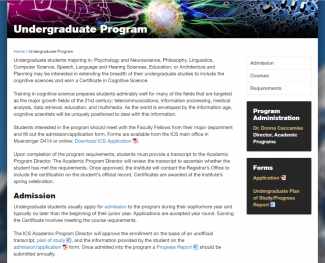Helping users understand the destination of links is an important step towards increasing the usability and accessibility of a webpage or email. Screen reader users often scan content for hyperlinks, so it is important to make sure your links make sense without their surrounding content. In most cases, the proper link text is probably already in your content, and it just needs to be emphasized as the link. Extraneous words used as links such as "click here" or "more" should be avoided in most situations, although if you dive into the WCAG guidelines on descriptive links, you'll learn a lot more.
Examples
 Example A
Example A
Use this: Learning what to write as proper link text can be confusing, but you can learn more by visiting Descriptive Links Accessibility.
Instead of: Learning what to write as proper link text can be confusing, but to learn more click here.
Example B
Use this: For a list of departments, see the Academic Programs page.
Instead of: Click here for a list of departments.
Recommendations
- Write links that make sense out of context. Use descriptive link text detailing the destination, not just "click here" or other similar phrases. Link text should be made up of phrases rather than single words so that users with limited motor control will not have difficulty hitting links. Note: Some search engines, such as Google, give higher rankings to sites that use "context-rich" text links.
- Using the button shortcode makes links accessible while giving them a more pronounced visual appearance on your page.
- If you use an image to create links, make sure the destination is included as an image ALT tag.
- Use link text and not the URL to create your hyperlinks.
